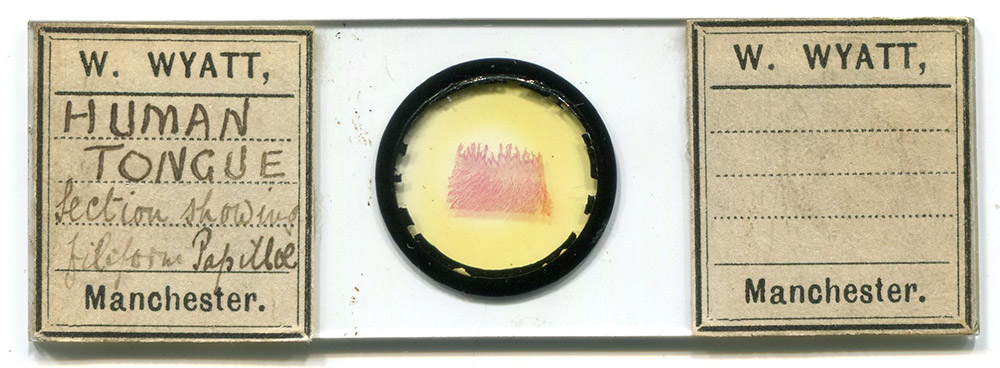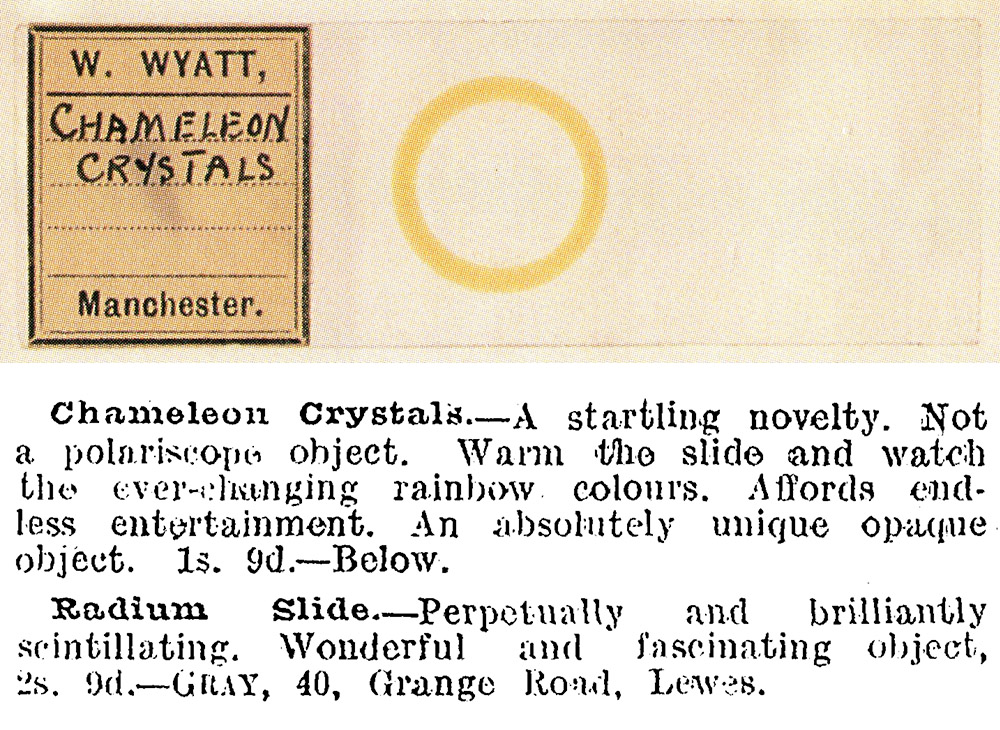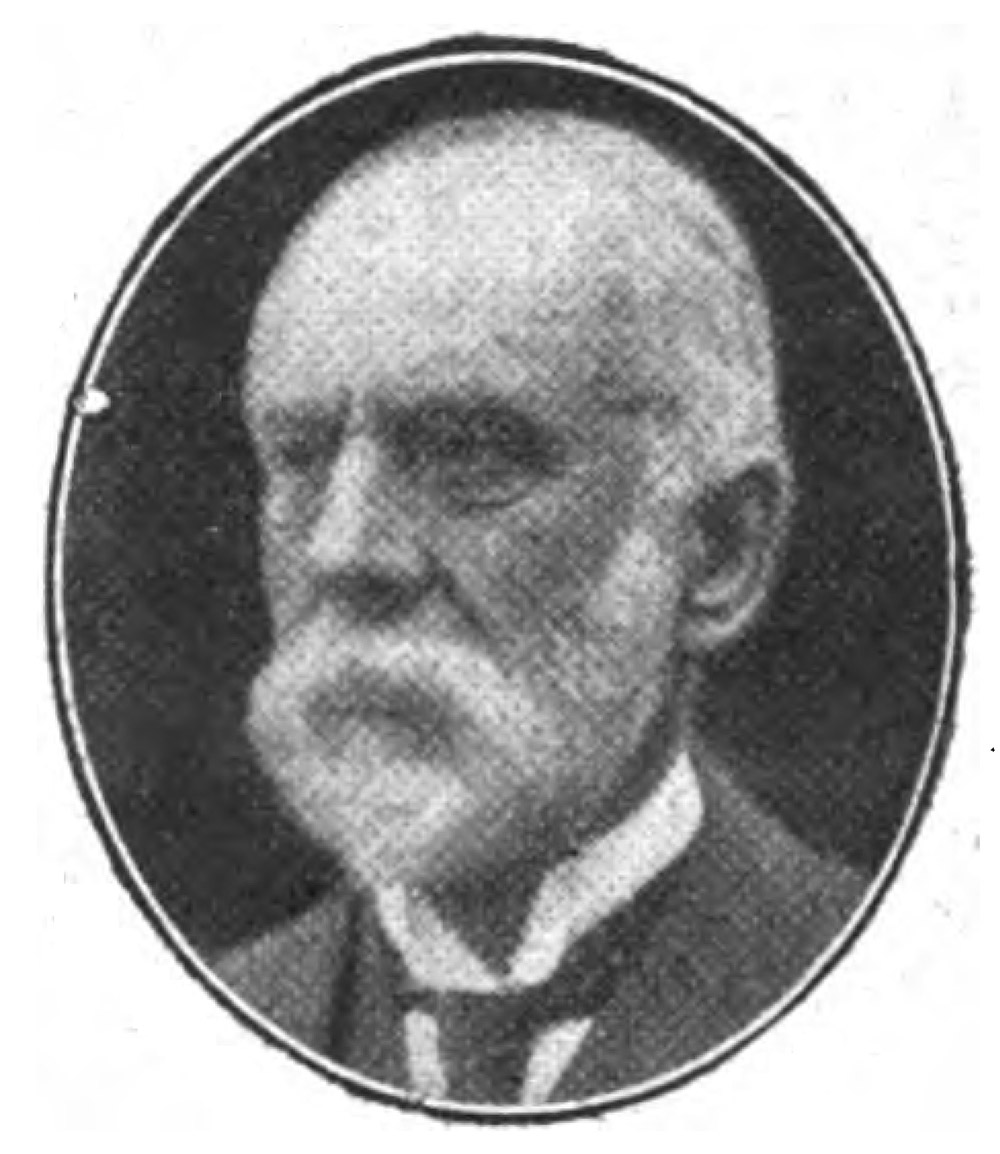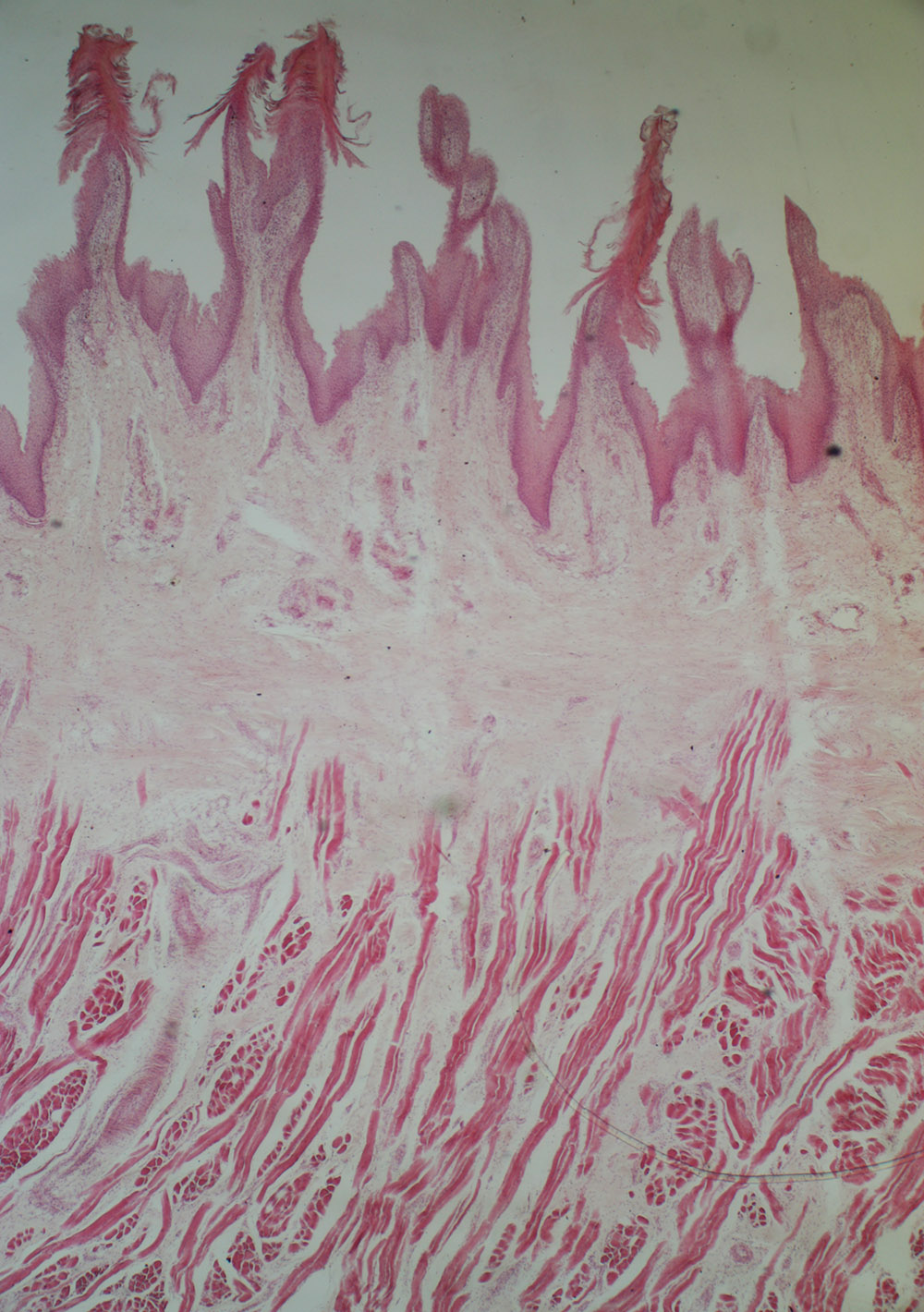
Figure 1. The label gives Wyatt’s address as “Manchester”, where he lived between ca. 1915 and 1928. He joined the Manchester Microscopical Society in 1920. The specimen is “human tongue section, showing filiform papillae”.
William Wyatt, 1866 - 1934
by Brian Stevenson
last updated March, 2024
William Wyatt was a pharmacist and pharmaceutical sales representative in the Midlands and North of England. In 1900, he became a Fellow of the Royal Microscopical Society, and, in 1920, a member and officer of the Manchester Microscopical Society. He left a number of good-quality microscope slides with his labels (Figures 1 and 2).

Figure 1.
The label gives Wyatt’s address as “Manchester”, where he lived between ca. 1915 and 1928. He joined the Manchester Microscopical Society in 1920. The specimen is “human tongue section, showing filiform papillae”.

Figure 2.
Brian Bracegirdle’s “Microscopical Mounts and Mounters” shows this slide with William Wyatt’s label as Plate 37-M. The curiously-named “chameleon crystals” were sold as mounted slides by professional mounter Hubert J. Gray (1882-1963) during the early-mid 1920s, suggesting that this slide was purchased from Gray and re-labeled by Wyatt. Advertisements by Gray from a 1922 issue of “The English Mechanics and World of Science” are shown below the image from the book.

Figure 3.
William Wyatt, from a 1928 announcement of his retirement.
William Wyatt was born on January 27, 1866, in Welbeck, Nottinghamshire. He was the elder son of Joseph and Susan Wyatt. The 1871 census listed Joseph’s occupation as “clerk of works”, while William’s marriage record listed his father’s occupation as “joiner” – perhaps he was a clerk for a woodworking business. The Wyatts enjoyed a fairly comfortable life, employing a domestic servant at the time of the 1871 census. Joseph died in 1875, leaving an estate of approximately £5000. The 1881 census listed Susan as an “annuitant”, with William and his two younger siblings living with her.
William Wyatt passed his preliminary examination for training as a pharmacist, and began his apprenticeship in 1880. His address was given as Mansfield, Nottinghamshire, implying that he worked with a pharmaceutical chemist in that town. He passed his final examinations in April, 1890, and was registered as a Pharmaceutical Chemist with the Pharmaceutical Society. Later references to Wyatt often include the initials Ph.C. after his name, to indicate that qualification.
Following graduation, Wyatt moved to Skerton, Lancashire, which was then on the outskirts of the city of Lancaster. He married Sophia Howson there on December 14, 1892. The pair had three children, all girls.
Training in pharmaceutical sciences during the later 1800s involved microscopical investigations of plant tissues and extracts, as well as other compounds, so that pharmacists could be certain of the substances that they used in preparing medicines. That was probably where Wyatt learned his appreciation of microscopes and their uses.
He joined the Royal Microscopical Society in November, 1900. He remained F.R.M.S. until the end of his life. There are no records of him having traveled to London to attend an R.M.S. meeting, but he undoubtedly appreciated the information provided by the society’s journals.
In about 1903, Wyatt joined the pharmaceutical firm of J. Woolley, Sons, and Co., serving initially as a traveling representative. The 1911 national census found the Wyatt family living in Newcastle-on-Tyne. They employed a domestic servant.
Around 1915, Wyatt joined the home staff of Woolley, and settled in Manchester. The family’s home was initially at 4 Addison Terrace, Victoria Park, Manchester, with a move to Rutland House, Ellesmere Park, Eccles in 1924.
He became a member of the Manchester Microscopical Society in 1920. He served on the Society’s Committee for several years. His skills as a microscopist are evident from his having presented a lecture to the M.M.S. on “manipulation of the microscope (advanced)” in February, 1924.
Wyatt retired from Woolley in 1928. This was announced in the Transactions of the Pharmaceutical Society, along with a summary of his work life and extracurricular activities:
“Mr. W. Wyatt, Ph.C., F.R.M.S., who, at the end of June relinquished his position on the staff of Messrs. J. Woolley, Sons, and Co., Ltd., Manchester, is well known and deservedly popular with pharmacists in Lancashire and the North of England, and it is with great regret that they will hear of his retirement. Mr. Wyatt represented Messrs. J. Woolley, Sons, and Co., Ltd., in the Midlands and the North of England for some ten years, and on leaving the road took a position on the home staff. He joined the firm twenty-five years ago, and during that time he has been an active the supporter of Manchester Pharmaceutical Association and an occasional contributor to its meetings. For some years he has been its honorary librarian, for which his literary attainments, his natural aptitude for historical research, and his profound knowledge of pharmacy law render him peculiarly fitted. All this knowledge he has always been ready to place at the disposal of his fellow-pharmacists. He is recognised an authority upon the history and lore of the Acts relating to Medicine Stamp Duty, having made a special study of all the enactments relating to this His particular subject. valuable collection of the different Acts and schedules is probably more complete than any other in the country, as pharmacists in London and elsewhere who have listened to his lecture on ‘The Acts of Parliament Relating to Stamped Medicines’ will remember."
"Outside of pharmacy, Mr. Wyatt has many interests. For many years he was on the Council of the Manchester Microscopical Society, frequently lecturing and demonstrating to the members. Of recent years his main activity has been the Lancashire and Cheshire Antiquarian Society, whose proceedings he follows with great interest. He is an old member of its council, and the occupancy of the presidential chair has several times been pressed upon him. Monastic and ecclesiastical architecture and inscribed and sculptured crosses have been another source of special study. On the artistic side he is a member of committee of the Manchester Arundel Society. This wide range of interests has made Mr. Wyatt a popular lecturer on a variety of subjects, and it would be difficult to estimate how many audiences have listened to his lecture on "Sherwood Forest," of which district he is a native. A few years ago he lectured before the Royal Antiquarian Society in London "Cockersand Abbey'."
"For about half a century Mr. Wyatt has been a worker in pharmacy, and pharmacists hope that his wide knowledge and experience will still be available for many years to come. In Manchester he has been a valuable asset to the Association. With time to devote to the various problems that face pharmacy, a wider sphere of usefulness may open out for him.”
In 1929, Wyatt made the following donations to the Manchester Museum, “Set of mounted specimens of poisonous and other plants. Objects mounted for the microscopes. Slide boxes and appliances for microscopic work.”
William Wyatt died in February, 1934.

Figure 4.
“Human tongue section, showing filiform papillae” (see Figure 1). Imaged with a 3.5x objective lens and C-mounted digital SLR camera on a Leitz Ortholux II microscope.
Resources
Annual Report and Transactions of the Manchester Microscopical Society (1920) Members, page 38
Annual Report and Transactions of the Manchester Microscopical Society (1924) page 10
Bracegirdle, Brian (1998) Microscopical Mounts and Mounters, Quekett Microscopical Club, pages 104 and 178, Plate 37-M
Chemist and Druggist (1925) Report on a presentation by William Wyatt to the Manchester Pharmaceutical Association, page 859
England census and other records, accessed through ancestry.com
English Mechanics and World of Science (1922 and 1924) Advertisements for “chameleon crystals” by H.J. Gray, pages 127 (1922) and 338 (1924)
Journal of the Royal Microscopical Society (1900) New Fellows, pages 740-744
Journal of the Royal Microscopical Society (1921) Fellows
The Pharmaceutical Journal (1900) “Mr. William Wyatt, M.P.S., of Lancaster, has been elected a Fellow of the Royal Microscopical Society”, December 1 issue, page a
The Pharmaceutical Journal and Pharmacist (1925) “Mr. William Wyatt, Ph.C., F.R.M.S., M.P.S., of Manchester, delivered a lantern lecture on 'Some Recent Excavations at Cockersand Abbey, Lancashire', before the British Archaeological Association, February 5”, page 194
The Pharmaceutical Journal and Transactions (1880) Apprentices or Students, page 117
The Pharmaceutical Journal and Transactions (1888) Associates, page 765
The Pharmaceutical Journal and Transactions (1890) Diplomas, page 917
Report of the Museum Committee (The Manchester Museum) (1929) Donations, page 28
Transactions of the Lancashire and Cheshire Antiquarian Society (1924) “Wyatt, William, Ph.C., F.R.M.S., Rutland House, Ellesmere Park, Eccles”, page 202
Transactions of the Pharmaceutical Society (1928) Personal and business, page 23
The Year-book of the Scientific and Learned Societies of Great Britain and Ireland (1922) “Manchester Microscopical Society ... Wyatt, W., F.R.M.S. – poisonous plants, Dec. 1”, page 163